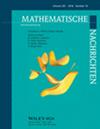三维强Lipschitz域边界上Sobolev空间H1的表征
IF 0.8
3区 数学
Q2 MATHEMATICS
引用次数: 0
摘要
在这项工作中,我们研究了强Lipschitz边界∂Ω上的Sobolev空间h1(∂Ω) $\mathrm{H}^{1}(\partial \Omega)$$\partial \Omega$,即Ω $\Omega$是一个强Lipschitz域(不一定有界)。在大多数文献中,这个空间是通过平面域上的图表和Sobolev空间来定义的。我们证明了通过Ω $\Omega$上的微分算子和直接在边界上导致相同空间的弱公式有一种不同的方法。H 1(∂Ω) $\mathrm{H}^{1}(\partial \Omega)$的第二个特征尤其有利,当涉及到H(旋度,Ω) $\mathrm{H}(\operatorname{curl},\Omega)$向量场的轨迹时。本文章由计算机程序翻译,如有差异,请以英文原文为准。

Characterizations of the Sobolev space H1 on the boundary of a strongly Lipschitz domain in 3-D
In this work, we investigate the Sobolev space on a strongly Lipschitz boundary , that is, is a strongly Lipschitz domain (not necessarily bounded). In most of the literature, this space is defined via charts and Sobolev spaces on flat domains. We show that there is a different approach via differential operators on and a weak formulation directly on the boundary that leads to the same space. This second characterization of is in particular of advantage, when it comes to traces of vector fields.
求助全文
通过发布文献求助,成功后即可免费获取论文全文。
去求助
来源期刊
CiteScore
1.50
自引率
0.00%
发文量
157
审稿时长
4-8 weeks
期刊介绍:
Mathematische Nachrichten - Mathematical News publishes original papers on new results and methods that hold prospect for substantial progress in mathematics and its applications. All branches of analysis, algebra, number theory, geometry and topology, flow mechanics and theoretical aspects of stochastics are given special emphasis. Mathematische Nachrichten is indexed/abstracted in Current Contents/Physical, Chemical and Earth Sciences; Mathematical Review; Zentralblatt für Mathematik; Math Database on STN International, INSPEC; Science Citation Index

 求助内容:
求助内容: 应助结果提醒方式:
应助结果提醒方式:


